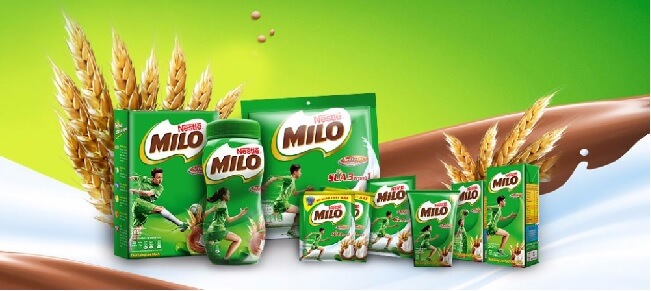If you are a lover of chocolate beverages, then you must have heard of the product, Milo. Even if you aren’t, Milo has been a household name for several years. It is a trusted brand and is one of the leading chocolate beverages in the world.
Milo contains essential minerals and vitamins that the body needs to meet its energy and nutrition needs. This product is great for both adults and children alike. It was first launched in Australia around the early 1930s and has been identified with good health and sports.
Milo is produced by Nestle Foods and has an array of products under its brand. We will be discussing the prices of these different products in this post.

Milo Price List in Nigeria
Milo is known for providing calcium, iron, different classes of vitamins, and several minerals. All of these contribute to good health and vitality. The question that begs an answer is, “How much do Milo products cost in Nigeria today?” There are so many products on the market so it is quite difficult to tell. However, we have surveyed the market on your behalf and gathered the prices of some of the popular Milo products available. Check the list below to find out the products and their prices:
- Nestle Milo Drink 1 kg + Dano cool cow 900g: From N14,900
- Nestle Milo 20g x 20: From N2,400
- Nestle Milo Active Go Energy Food Drink Tin 500g x 3 pieces: From N10,000
- Nestle Milo Refill 400g: From N2,700
- Nestle Milo Refill 900g: From N5,300
- Nestle Milo 20g x 1 carton (240 pieces): From N28,000
- Nestle Milo 20g x 10: From N1,200
- Nestle Milo 20g (10 sachets each roll): From N1,200
- Nestle Milo Tin 1 kg: From N5,500
- Nestle Milo 20g x 240 (24 rolls): From N28,000
- Nestle Milo Hot Chocolate Milo Sachet 20 g x 1 carton: From N28,000
- Nestle Milo 20g x 40: From N4,800
- Nestle Milo Tin 500g: From N3,800
- Nestle Milo Crunchy 320g: From N2,500
- Nestle Milo Hot Chocolate Refill 400g x 3: From N8,100
PRICES LAST UPDATED: MARCH 13, 2024.
Note that these prices can change depending on several factors. Some of these factors include changes in company policies, government policies, location of purchase, and vendors. We will update this post once we notice new prices on the market. With this out of the way, let’s discuss some other important facts about Milo.
Interesting Facts About Milo That You Should Know
Milo is a malt powder and chocolate drink that is produced by Nestle Foods. You can mix it with either cold or hot water to produce a delicious beverage. This powder is mostly placed in green tins or sachets that are made of aluminum foil, polyethylene, and polyethylene terephthalate all laminated together.
Many people consume Milo all over the world but have very little knowledge about this product. In this section of this post, we will share a few important facts about Milo that you should know.
Origin of Milo
Many people believe that Milo originated from Switzerland because this country is home to the headquarters of Nestle Foods. Well, that notion is wrong as this product was first manufactured in Sydney, Australia by Thomas Mayne in 1934.
Milo isn’t for everybody (Allergen declaration)
Milo is made up of several ingredients including sugar, malt, and cocoa. You can find the full ingredients list on the Milo can or sachet. Malt is produced mostly from sorghum or barley and both grains contain gluten that some people react to. Interestingly, Nestle seems to have found a way to bypass gluten as it is not mentioned on their ingredients list. While you don’t need to worry about gluten, you need to be wary about Milo if you are lactose intolerant. The reason is that Milo is very rich in milk and can you react negatively to the product. Nestle has a message on all the Milo packages to show that there may be allergens so consumers should study the ingredient list first.
The proportion of Malt to Cocoa
This is another interesting fact that most people wouldn’t have guessed about Milo. There is more Malt by weight than Cocoa in Milo which is strange considering everyone thinks Milo is a cocoa drink. However, when you look at the ingredients list, it shows that there is more malt than cocoa in Milo.
Milo is pronounced as spelled
Nigerians and many other Africans pronounce the “i” in Milo as “i” instead of “ai.” If you use the latter pronunciation, it will be pronounced as / maɪloʊ/ not /ˈmɪloʊ/. The truth is that it is going to be quite difficult for many people to adjust their pronunciation of this word and it is quite understandable. Trying to change it now will make everyone think you are wrong and they are right.
Possible Addiction
It is no secret that one can become addicted to coffee, but who knew the same could happen with Milo? Well, it is not just Milo that is the culprit here, any food containing cocoa can result in addiction. The caffeine in coffee is what results in addiction but what causes addiction to Milo? Cocoa, which is a principal ingredient in this beverage, contains theobromine. This chemical is a xanthine alkaloid that shares similarities with caffeine. This is why you can become addicted to Milo when you start to take above 15 teaspoons daily.
Quantity of Sugar
One would have thought that there would be more cocoa, malt, or even milk than sugar in Milo. Turns out that the opposite is the case when you consider the ingredients by weight. Of course, it isn’t just the regular sucrose that makes up all the sugar in Milo. There’s lactose from the milk and maltose from sorghum. So, while table sugar is minimal in this product, there’s a lot of natural sugar in Milo which is healthy for consumption.
Milo and Coke share the same glycemic index
Studies in both Switzerland and Australia show that when you dissolve Milo in water, it has the same glycemic index as Coke. Both share a glycemic index of 55 which you can reduce in Milo by dissolving it in milk instead.





